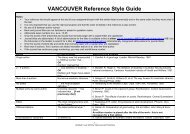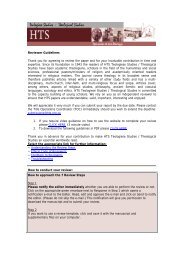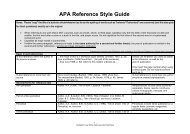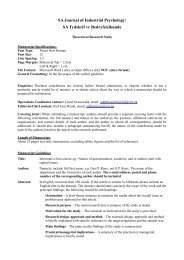Quantitative Research
Quantitative Research
Quantitative Research
You also want an ePaper? Increase the reach of your titles
YUMPU automatically turns print PDFs into web optimized ePapers that Google loves.
Statistical analysis (third-level heading)<br />
Normally, only a brief mentioning of the statistical procedures employed in the analyses of the data is<br />
provided. See the opposite example. In the event of unusual or new statistical techniques a brief description<br />
of each is then also provided under this heading. The description of familiar statistical procedures is<br />
otherwise incorporated into the presentation of the results.<br />
RESULTS (first-level heading)<br />
The next first-level heading is RESULTS, which appears in capital letters, in bold and is centred.<br />
The results section can be divided broadly into two sections:<br />
• Firstly, an overview of the descriptive statistics of each scale (only if space permits), as well as the<br />
reliability statistics for each scale is provided.<br />
• Secondly, an overview of the inferential statistics according to all stated hypotheses is provided.<br />
• Keep the following guidelines in mind when presenting the results of your study:<br />
• present your results as concisely as possible;<br />
• use tables and figures selectively, by not cluttering the article with tables and figures;<br />
• cross-references to relevant tables or figures should precede the mentioned table or figure;<br />
• interpret the contents of a table or a figure for the reader;<br />
• follow established conventions when reporting statistical data; and<br />
• report the statistical hypotheses (both the null and the alternative hypotheses) when reporting the<br />
results.<br />
DISCUSSION (first-level heading)<br />
The next heading is DICUSSION, which appears in capital letters, in bold and centred.<br />
This section normally contains the following eight elements:<br />
• restate the main objective of the study;<br />
• reaffirm the importance of the study by restating its main contributions;<br />
• summarise the results in relation to each stated research objective or research hypothesis;<br />
• link the findings back to the literature and to the results reported by other researchers;<br />
• provide explanations for unexpected results;<br />
• provide the conclusions and recommendations (implications for practice);<br />
• point out the possible limitations of the study; and<br />
• provide suggestions for future research.<br />
Second and third-level headings may be used in this section.<br />
REFERENCES (first-level heading)<br />
References begin on a separate page. References cited in the text should all be included in the list at the end<br />
of the paper. Full references at the end of the paper, arranged alphabetically by surname, chronologically<br />
within each name, with suffixes a, b, c, etc. to the year for more than one per year by the same author. Note<br />
that the second and subsequent lines are indented. This journal makes use of the APA reference style. We<br />
have an APA style guide which you can be download from the journal website.




![Reference Style Guide [17-09-2008 Tdv].pdf](https://img.yumpu.com/42195443/1/184x260/reference-style-guide-17-09-2008-tdvpdf.jpg?quality=85)



